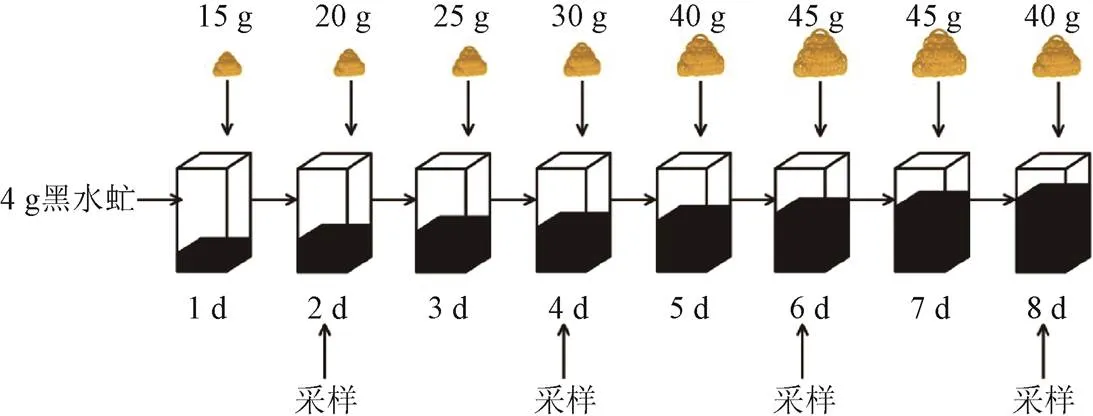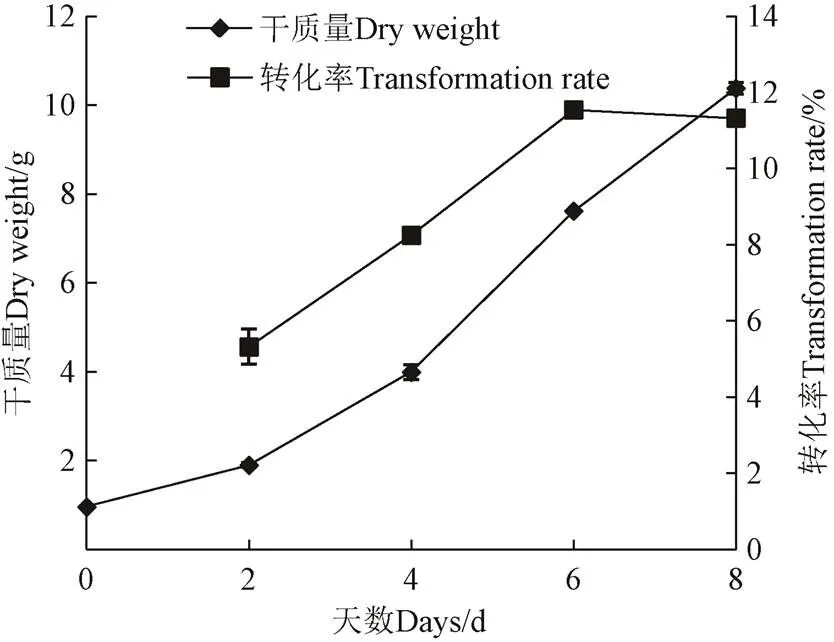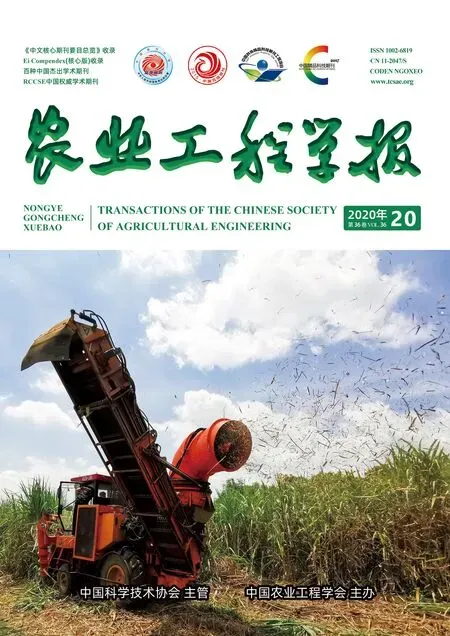黑水虻生物轉化豬糞過程中重金屬的遷移變化
王小波,蔡瑞婕,耿維娜,毛志月,趙 毅,蔣會東,徐曉燕
黑水虻生物轉化豬糞過程中重金屬的遷移變化
王小波,蔡瑞婕,耿維娜,毛志月,趙 毅,蔣會東,徐曉燕※
(天津農學院農學與資源環境學院,天津 300384)
利用黑水虻處理豬糞為一種高效的環境友好型的技術,但豬糞中重金屬的含量對黑水虻的轉化產生影響。該研究在30 ℃環境下豬糞中接種7日齡的黑水虻幼蟲,研究黑水虻的生長和對豬糞的轉化效率,以及豬糞中的重金屬(Cu、Zn、Cr、Cd、As)在黑水虻蟲體和蟲糞中的變化情況。結果表明:在8 d的生長過程中,0~2 d時,生長速率最慢,4~6 d時生長速率最快,在第8天時蟲體干質量最高。黑水虻對豬糞的轉化率隨著時間的延長而增加,在第6天時達到了最大11.5%,而到第8天時下降。在轉化過程中蟲體中Cu、Cr、As的濃度隨著黑水虻幼蟲生長降低,在第8天時,蟲體Cu、Cr、As濃度較第2天分別降低了24.5%、21.7%、33.1%。Cd含量隨著黑水虻幼蟲生長增加,在第8天時,蟲體Cd濃度較第2天增加了75.3%。Cu、Cr、As、Cd在蟲糞中濃度的變化同蟲體變化相反。Zn在蟲體和蟲糞中含量沒有發生顯著變化。在第8天時蟲糞中的Cd含量顯著低于豬糞,而Cu、Cr、As、Zn含量與豬糞比沒有顯著差異。黑水虻幼蟲對豬糞中Cd的富集系數最高,達到了3.8,其余都小于1,各重金屬的富集順序從大到小依次為Cd、Zn、Cu、Cr、As。轉化后Cu、Cr、As、Zn有83.6%~92.7%分布于蟲糞,而Cd有49.8%~69.7%分布于蟲糞,30.3%~50.2%分布于蟲體。轉化后Cu、As的生物活性提高,Cr、Cd的生物活性降低,Zn的生物活性沒有明顯的變化。研究結果為畜禽糞便的黑水虻生物轉化提供參考。
糞;重金屬;黑水虻;蟲糞;形態
0 引 言
近年來中國畜禽養殖業快速發展,已經成為農業和農村經濟發展的支柱產業之一[1]。但大量養殖廢棄物未得到及時有效的處理和應用,成為環境治理的一大難題[2]。2016年中國畜禽廢棄物年產量約38億t,其中生豬糞污年產量約18億t,占到47%,而這些廢棄物的綜合利用率只有60%[3-4],大量的未利用的養殖廢棄物嚴重影響了周圍的大氣、土壤、水體和環境衛生[5-6]。為保證畜牧業的健康發展,減少畜禽糞便帶來的環境污染等一系列問題,糞便的無害化處理及利用成為了農業環境研究的熱點之一[7]。其中能以動物糞便為食的腐生性昆蟲在畜禽廢棄物處理中得到初步的研究與應用[8-9]。
黑水虻,又名亮斑扁角水虻,腐生性的水虻科昆蟲,幼蟲主要以腐爛有機物、動物糞便等為食,在取食動物糞便時能夠對糞便中的營養物質進行轉化并有效減少糞便臭味,降低糞便中的病菌、抗生素等有害物數量[10-11];黑水虻幼蟲中含有豐富的蛋白質、脂肪、鈣、磷等營養物質,是良好的生物蛋白飼料[12-13]。利用黑水虻幼蟲處理畜禽糞便,轉化后的產物高蛋白蟲體和蟲糞有機肥都具有較高的經濟價值,既可消除禽畜糞便對環境的污染、實現糞污就近就地利用,同時還能增加養殖收入,為畜禽糞便的處理提供了一種經濟、可行的途徑,受到了國內外的廣泛關注[14-15]。
在畜禽養殖過程中,為了提高飼料利用率,促進畜禽生長發育,降低養殖成本,常在飼料中添加各種重金屬微量元素[16-17],但由于畜禽對微量元素的利用率很低,大部分通過糞便排出體外,造成了畜禽糞便中各種重金屬元素的含量超標[18-19]。黑水虻處理畜禽糞便的過程中,重金屬會在黑水虻體內積累[20],而且前人的研究也發現黑水虻對重金屬具有較強的耐受能力[21-22]。但在黑水虻轉化處理畜禽糞便過程中黑水虻體內和蟲糞中重金屬的變化情況還未見報道,本文研究了在黑水虻處理豬糞過程中各種重金屬在蟲體和蟲糞中含量的變化情況。以期為黑水虻轉化處理畜禽糞便,及轉化產物的資源化利用提供參考。
1 材料與方法
1.1 試驗材料
豬糞取自天津市靜海區某養殖場,其基礎理化指標為有機質含量84.7%,全氮1.79%,P2O52.66%,K2O 1.87%,pH值6.19,電導率10.22 mS/cm,重金屬Cu、Zn、Cr、Cd、As含量分別為395.7、408.2、93.1、1.3、2.3 mg/kg。
黑水虻卵取自天津農學院有機廢棄物資源化技術研發中心,蟲卵在溫度(30±2)℃,濕度(80±5)%的環境中,孵化48 h后,轉入含水量80%的麥麩中,在溫度(30±2) ℃環境中保育7 d后,放入豬糞中進行試驗。蟲體重金屬Cu、Zn、Cr、Cd、As含量分別為21.77、185.53、0.26、0.34、0.01 mg/kg。
1.2 試驗設計
在12個培養盒(21 cm ×15. 5 cm ×10 cm)中,分別放入7日齡黑水虻幼蟲4 g,在溫度(30±2)℃,濕度60%~80%的環境中養殖,每天待豬糞轉化完后再加入適量濕度70%豬糞(圖1),在第2天、4天、6天、8天豬糞加入前,各取3盒,停止加入豬糞,放置24 h,待蟲體完全排出體內殘余豬糞后篩分。

圖1 黑水虻處理豬糞過程樣品的添加與采樣
1.3 測定項目與方法
篩分出蟲體、蟲糞后,蟲體微波烘干(功率1 kW,時間5 min)后,稱總質量。測蟲體重金屬含量:稱0.500 0 g粉碎后的樣品加入8 mL HNO3和2 mL H2O2放入CEM-MARS 6S微波消解,180 ℃,保持15 min,消解后取出消解管,置于智能控溫電加熱器上140℃趕酸至近干,將管中溶液轉移至 50mL 容量瓶中,用去離子水定容,ICP-MS(Thermo)測定重金屬含量。
蟲糞風干后,稱質量,烘干法測含水量。稱0.500 0 g風干粉碎后的豬糞、蟲糞加入6 mL HNO3、2 mL HCl和2 mL H2O2,微波消解,參數設置同上,趕酸后定容至50 mL,用ICP-MS(Thermo)測定重金屬含量。采用BCR修正形態分級法[23]提取豬糞、第8天轉化結束后蟲糞中各重金屬F1弱酸溶解態、F2可還原態、F3可氧化態、F4殘渣態,ICP-MS測定。
轉化率=蟲體干質量增加量/投喂的料干質量(1)
生物富集系數=蟲體重金屬含量/豬糞重金屬含量 (2)
1.4 數據處理
試驗數據計算、作圖采用Excel2010 軟件完成,顯著性差異分析采用SPSS 17. 0 Duncan’s 新復極差法(<0.05)完成。
2 結果與分析
2.1 黑水虻蟲體生物量和對豬糞轉化率的變化
黑水虻蟲體干質量隨著生長時間的延長而增加(圖 2),在第8天時干質量最高,達10.38 g,在0天到2天時,生長速率最慢,在4 天到6 天時生長速率最快。黑水虻對豬糞的轉化率隨著時間的增加而增加,在第6天時達到了最大11.5%,而到第8天時下降。

圖2 黑水虻蟲體生物量和對豬糞轉化率的變化
2.2 重金屬在蟲體、蟲糞中的變化
豬糞經黑水虻轉化過程中,豬糞中的重金屬部分轉移到黑水虻蟲體,使蟲體各種金屬含量顯著提高(表 1)。隨著黑水虻幼蟲生長,蟲體中的重金屬濃度也發生變化,且不同重金屬的變化規律不同。蟲體中Cu、Cr、As的濃度隨著黑水虻幼蟲的生長而降低,在第8 天時,蟲體Cu、Cr、As濃度較第2 天分別降低了24.5%、21.7%、33.1%。蟲體Cd的濃度隨著黑水虻幼蟲的生長而增加,在第8天時,蟲體Cd濃度為5.05 mg/kg,較第2天增加了75.3%。而蟲體Zn的濃度在黑水虻幼蟲第2天到第8天的生長過程中沒有顯著變化。

表1 蟲體與蟲糞中重金屬的含量
注:同列不同小寫字母表示在0.05 水平上差異顯著,下同。
Note: Different lower case letters in the same column indicate significant differences at the 0.05 level, same as below.
豬糞經黑水虻轉化過程中,豬糞中的重金屬部分轉移到黑水虻蟲糞。隨著黑水虻幼蟲生長,蟲糞中的重金屬濃度也發生變化,且不同重金屬的變化規律不同(表 1)。蟲糞中Cu、Cr、As含量在轉化初期第2天,第4天時含量低于原豬糞含量,而隨著黑水虻生長蟲糞中的Cu、Cr含量增加,到第8天時,同原豬糞含量沒有差異。蟲糞中Zn含量在黑水虻生長過程中同原豬糞相比沒有顯著變化。蟲糞中Cd含量隨著黑水虻的生長而降低,在第8天時,含量最低(0.97 mg/kg),較原豬糞降低了27.1%。
2.3 黑水虻對各重金屬的生物富集系數
豬糞經黑水虻轉化后,黑水虻對不同重金屬有不同的生物富集系數(圖3),Cd的富集系數最高,達到了3.8,其次為Zn、富集系數為0.99,Cu、Cr、As的富集系數分別為0.55、0.44、0.43。
2.4 不同重金屬在蟲體、蟲糞的分配比例
豬糞中的重金屬經黑水虻轉化后,分布于黑水虻蟲體和蟲糞(表2),其中Cu、Cr、As、Zn主要分布于蟲糞,占83.6%~92.7%,而Cd在蟲體的分配比例為30.3%~50.2%,在蟲糞的分配比例為49.8%~69.7%。在轉化過程中隨著黑水虻的生長,Cu、Cr、As在蟲體的分配比例隨著天數的增加而降低,Cu由11.8%降低到9.1%,Cr由11.2%降低到7.4%,As由11.8%降低到7.3%。Cd在蟲體的分配比例隨著天數的增加而提高,由30.3%增加到50.2%,Zn在蟲體(15.2 %~16.4 % )和蟲糞(83.6 %~84.8 %)中的分配比例沒有隨著黑水虻的生長而發生顯著變化。

圖3 不同重金屬的生物富集系數

表2 不同重金屬在蟲體蟲糞的分配比例
2.5 豬糞經黑水虻轉化后各重金屬形態的變化
豬糞將黑水虻轉化后,在蟲糞中各重金屬的形態發生了變化(表3)。蟲糞中Cu的F1含量較原豬糞增加了201.7%,F2、F3含量分別下降了14.5%和22.2%,F4含量沒有顯著變化。Zn的各形態含量都沒有顯著變化。Cr的F1、 F2含量分別降低了13.4%和29.8%,F3、 F4含量分別增加了84.2%和117.4%。Cd的F1、 F2、F3含量分別降低了26.5%、33.3%和60.0%,F4含量增加了20.0%。As的F1、 F3、F4含量分別增加了9.0%、29.7%和45.5%,F2含量降低了43.8%。

表3 豬糞、蟲糞中重金屬各形態含量
注:同一金屬同行數字后不同小寫字母表示在0.05水平上差異顯著。
Note: For the same metal, different lower case letters after peer numbers indicate significant differences at the 0.05 level.
3 討 論
環境條件對黑水虻轉化處理畜禽糞便具有較大的影響[24],在已有研究的基礎上,選擇最佳環境條件溫度30 ℃、濕度80%、豬糞濕度70%進行試驗。在此環境條件下,7日齡的黑水虻幼蟲經過8 d的生長即將進入預蛹期,為最佳的商品蟲收獲期。在黑水虻生長過程中,前期因為幼蟲的個體小、食量小,蟲體質量增加較慢,在中期隨著黑水虻幼蟲個體的變大,食量增加,蟲體質量也增加較快,在試驗中第4天到第6天是黑水虻干質量增加最快的時期,同袁橙等[24]的研究結果一致,后期因幼蟲即將進入預蛹期,食量下降,蟲體質量增加變慢。同時中期也是轉化效率最高的時期,在第6天時,黑水虻對豬糞的轉化效率最高。
黑水虻對不同金屬元素的吸收機制不同,因而對不同的金屬元素的富集和耐受規律也不同[21-22],在本試驗中黑水虻對豬糞中各種金屬的富集順序為Cd> Zn>Cu>Cr>As。黑水虻幼蟲與其他昆蟲種類相比具有極高的Ca含量[25],而鎘與鈣擁有相似的離子半徑,可以被熱休克蛋白通過鈣離子通道進行運輸,而不依賴于細胞胞吞作用或需要ATP的離子泵[26-27],造成黑水虻幼蟲對鎘的高富集(BAF 3.8)。其他的研究也表明昆蟲對重金屬元素的攝入會提高體內金屬硫蛋白的水平,重金屬元素與金屬硫蛋白結合或螯合在囊泡中,從而有效地使這些金屬失活,積累在昆蟲體內,在某些情況下,這些物質通過胞吐到消化道內腔排出[28-29],殘留于蟲糞中,使蟲體免收危害,這可能就是黑水虻體內能累積大量鎘的原因。
Zn是生物體維持機體正常生理功能和生長發育所必須的微量元素[30],Zn在黑水虻體內分布于中腸、脂肪體、表皮,分布的規律為中腸>脂肪體>表皮[31],對昆蟲來說鋅是一種重要,但同時具有潛在毒性的元素,昆蟲體內的存在的金屬結合相應轉錄因子-1(MTF-1)[32],能夠主動調節昆蟲對鋅的吸收,使鋅的BAF隨食物中鋅濃度變化而變化[20],在家蠅幼蟲生物體具有類似的調節機制[33]。本試驗中黑水虻對鋅的富集系數高于除Cd外的其他元素。Cu主要存在于雙翅目昆蟲幼蟲中腸上皮細胞的細胞漿內[34],As也主要存在于黑水虻于腸道內[21],都會隨著黑水虻的生長代謝而排出體外,所以黑水虻對Cu,As的生物富集也較低。在黑水虻幼蟲的生長過程中,前期黑水虻幼蟲個體小,生長發育慢,對豬糞的轉化率也低,造成了重金屬Cu、Cr、As在蟲體累積的濃度高,后期隨著黑水虻幼蟲生長代謝加快,對豬糞的轉化率也提高,重金屬Cu、Cr、As在蟲體累積的濃度降低。由于黑水虻對Cd的特殊吸收機制,而且本試驗豬糞中Cd的濃度遠低于黑水虻對Cd的耐受值[35],所以在黑水虻幼蟲生長過程中體內Cd的含量一直在提高。由于黑水虻對Zn的調節吸收,使黑水虻體內Zn的濃度沒有發生顯著變化。豬糞中的重金屬一部分被蟲體吸收后,剩余的隨蟲糞排出體外,所以蟲糞中各種重金屬濃度的含量變化同蟲體相反,蟲糞中Cu、Cr、As的濃度隨著黑水虻生長增加,第8天時,同原豬糞濃度相比沒有顯著變化,而蟲糞中Cd的含量隨著黑水虻的生長而降低,Zn在蟲糞中的濃度不隨著黑水虻的生長而變化。
豬糞中的重金屬轉移到黑水虻蟲體和蟲糞,對黑水虻蟲體和蟲糞的進一步應用帶來的環境風險,對照中國《飼料衛生標準》GB 10378—2017對飼料原料中Cd、Cr、As的限值標準,蟲體中的Cd、Cr含量超出限值,在應用時應注意配比,使在飼料標準的安全范圍內。對照中國有機肥標準NY/T 3442—2019,豬糞和蟲糞中的重金屬含量都在安全限值之內,對照歐盟堆肥生態標準[36]原豬糞中Cu、Zn、Cd超出了限值,經黑水虻轉化后蟲糞中Cd含量降低到安全限值以下。
有機肥中的重金屬對作物生長的影響除與重金屬的總量有關外,還與重金屬的存在形態有關,重金屬的形態直接影響重金屬的毒性、遷移及其在自然界中的循環[37]。本研究采用BCR法將豬糞、蟲糞中的各種重金屬分為弱酸溶解態、可還原態、可氧化態、殘渣態。其中弱酸溶解態最容易被吸收,生物活性最大,從試驗結果可見豬糞經黑水虻轉化后,在蟲糞中Cu、As的生物活性提高,Cr、Cd的生物活性降低,Zn沒有發現明顯的變化。張文娟[38]對蠅蛆轉化豬糞的研究結論表明Cu、Zn的生物活性提高,Cr、Cd的生物活性降低,與本研究結果較一致,但Zn的變化存在差異,可能與黑水虻和蠅蛆的生理代謝不同有關。
4 結 論
利用黑水虻幼蟲處理豬糞,可以實現對豬糞的高值高效資源化利用,解決豬糞的環境污染問題。在轉化過程中蟲體中Cu、Cr、As的濃度隨著黑水虻幼蟲生長降低,Cd含量隨著黑水虻幼蟲生長增加,在蟲糞中正好相反。Zn在蟲體和蟲糞中含量沒有隨黑水虻幼蟲的生長發生顯著變化。轉化結束后豬糞中的重金屬大部分累積于黑水虻蟲糞中(49.8%~92.7%)。黑水虻蟲體對豬糞中各重金屬的富集從大到小依次為Cd、Zn、Cu、Cr、As。經轉化后豬糞中Cu、As的生物活性提高,Cr、Cd的生物活性降低,Zn沒有發生明顯的變化。
[1] 王明利. 改革開放四十年我國畜牧業發展:成就、經驗及未來趨勢[J]. 農業經濟問題,2018(8):60-70. Wang Mingli. China's livestock industry development: Achievements, experiences and future trends[J]. Issues in Agricultural Economy, 2018(8): 60-70. (in Chinese with English abstract)
[2] 田慎重,郭洪海,姚利,等. 中國種養業廢棄物肥料化利用發展分析[J]. 農業工程學報,2018,34(增刊1):123-131. Tian Shenzhong, Guo Honghai, Yao Li, et al. Development analysis for fertilizer utilization of agricultural planting and animal wastes in China[J]. Transactions of the Chinese Society of Agricultural Engineering (Transactions of the CSAE), 2018, 34(Supp.1): 123-131. (in Chinese with English abstract)
[3] 中國畜牧獸醫年鑒編輯委員會. 中國畜牧獸醫年鑒2017[M]. 北京:中國農業出版社,2017.
[4] 農業部. 全國每年 38 億噸畜禽廢棄物綜合利用率只有6成[J]. 家禽科學,2018(3):5.
[5] Martinez J, Dabert P, Barrington S, et al. Livestock waste treatment systems for environmental quality, food safety, and sustainability[J]. Bioresource Technology, 2009, 100(22): 5527- 5536.
[6] Juma M, Sardar K, Jian Q, et al. Antibiotics in poultry manure and their associated health issues: A systematic review[J]. Journal of Soils and Sediments, 2020, 20: 486-497.
[7] 孫敬都,羅印林,王可心,等. 畜禽糞便無害化處理技術研究進展[J]. 今日畜牧獸醫,2019,35(1):63-65.
[8] Kashifur R, Minmin C, Xiao Xiaopeng, et al. Cellulose decomposition and larval biomass production from the co-digestion of dairy manure and chicken manure by mini-livestock ()[J]. Journal of Environmental Management, 2017, 196: 458-465.
[9] Zhu Fengxiang, Yao Yanlai, Wang Sujuan, et al. Housefly maggot-treated composting as sustainable option for pig manure management[J]. Waste Management, 2015, 35: 62-67.
[10] Minmin C, Ma Shiteng, Hu Ruiqi, et al. Rapidly mitigating antibiotic resistant risks in chicken manure by Hermetiaillucens bioconversion with intestinal microflora[J]. Environmental Microbiology, 2018, 20(11): 4051-4062.
[11] 梅瀚杰,胡文鋒. 黑水虻對有害物質的降解作用研究進展[J]. 飼料工業,2019,40(20):59-64. Mei Hanjie, Hu Wenfeng. A review of degradation of harmful substance by black soldier fly[J]. Feed Industry, 2019, 40(20): 59-64. (in Chinese with English abstract)
[12] 喻國輝,陳燕紅,喻子牛,等. 黑水虻幼蟲和預蛹的飼料價值研究進展[J]. 昆蟲知識,2009,46(1):41-45. Yu Guohui, Chen Yanhong, Yu Ziniu, et al. Research progression on the larvae and prepupae of black soldier fly Hermetia illucens used as animal feedstuff[J]. Chinese Bulletin of Entomology, 2009, 46(1): 41-45. (in Chinese with English abstract)
[13] Wang Shengyin, Wu Lingli, Li Baoling, et al. Reproductive potential and nutritional composition of Hermetia illucens (Diptera: Stratiomyidae) prepupae reared on different organic wastes[J]. Journal of Economic Entomology, 2020, 113(1): 527-537.
[14] Stefan Diener, Nandayure M. Studt Solano, Floria Roa Gutiérrez, et al. Biological treatment of municipal organic waste using black soldier fly Larvae[J]. Waste Biomass Valor, 2011, 2: 357-363.
[15] Kashifur Rehman, Cai Minmin, Xiao Xiaopeng, et al. Cellulose decomposition and larval biomass production from the co-digestion of dairy manure and chicken manure by mini-livestock()[J]. Journal of Environmental Management, 2017, 196:458-465.
[16] 黃玉溢,陳桂芬,劉斌,等. 廣西集約化養殖豬飼料Cu和Zn含量及糞便Cu和Zn殘留特性研究[J]. 安徽農業科學,2012,40(17):9280-9281,9284. Huang Yuyi, Chen Guifen, Liu Bin, et al. Content of Cu and Zn in pig feeds and their residual character in pig manures from intensive piggery in Guangxi[J]. Journal of Anhui Agricultural Sciences, 2012, 40(17): 9280-9281, 9284. (in Chinese with English abstract)
[17] 吳大偉,李亞學,吳萍,等. 規模化豬場育肥豬飼料、豬肉及糞便中重金屬含量調查[J]. 畜牧與獸醫,2012,44(4):38-40. Wu Dawei, Li Yaxue, Wu Ping, et al. Investigation on heavy metals in feed, pork and feces of fattening pigs in large scale pig farm[J]. Animal Husbandry & Veterinary Medicine, 2012, 44(4): 38-40. (in Chinese with English abstract)
[18] Hashe M I, Maj I D. Heavy metal concentrations in bovine tissues (muscle, liver and kidney) and their relationship with heavy metal contentsin consumed feed[J]. Ecotoxicology and Environmental Safety, 2018, 154(10): 263-267.
[19] 潘尋,韓哲,賁偉偉. 山東省規模化豬場豬糞及配合飼料中重金屬含量研究[J]. 農業環境科學學報,2013,32(1):160-165. Pan Xun, Han Zhe, Ben Weiwei. Heavy metal contents in pig manure and pig feeds from Intensive pig farms in Shandong Province, China[J]. Journal of Agro-Environment Science, 2013, 32(1): 160-165。(in Chinese with English abstract)
[20] Diener S, Zurbruegg C, Tockner K. Bioaccumulation of heavy metals in the black soldier fly, Hermetia illucens and effects on its life cycle[J]. Journal of Insects as Food and Feed, 2015, 1(4): 261-270.
[21] Vander Fels-Klerx H J, Camenzuli L, van der Lee M K, et al. Uptake of cadmium, lead and arsenic by Tenebrio molitor and Hermetia illucens from contaminated substrates[J]. Plos One, 2016, 11(11): 166-186.
[22] Biancarosa I, Liland N S, Biemans D, et al. Uptake of heavy metals and arsenic in black soldier fly (Hermetia illucens) larvae grown on seaweed-enriched media[J]. Journal of the Science of Food and Agriculture, 2018, 98(6): 2176-2183.
[23] Cai Minmin, Hu Ruiqi, Zhang Ke, et al. Resistance of black soldier fly (Diptera: Stratiomyidae) larvae to combined heavy metals and potential application in municipal sewage sludge treatment[J]. Environmental Science and Pollution Research international, 2018, 25(2): 1559-1567.
[24] 袁橙,魏冬霞,解慧梅,等. 黑水虻幼蟲處理規模化豬場糞污的試驗研究[J]. 畜牧與獸醫,2019,51(11):49-53. Yuan Cheng, Wei Dongxia, Xie Huimei, et al. Research on treatment of fecal pollution on large scale pig farms with black soldier fly larva[J]. Animal Husbandry & Veterinary Medicine, 2019, 51(11): 49-53. (in Chinese with English abstract)
[25] Finke M D, Oonincx D G A B. Insects as Food for Insectivores[M]//Mass Production of Beneficial Organisms, Academic Press,2014: 583-616.
[26] Braeckman B, Smagghe G, Brutsaert N, et al. Cadmium uptake and defense mechanism in insect cells[J]. Environmental Research, 1999, 80: 231-243.
[27] Craig A, Hare L, Tessier A. Experimental evidence for cadmiumuptake via calcium channels in the aquatic insect Chironomusstaegeri[J]. Aquatic Toxicology, 1999, 44(4): 255-262.
[28] Postma J F, Vannugteren P, Marion B. Buckert‐ De Jong. Increased cadmium excretion in metal‐adapted populations of the midge Chironomus riparius (diptera)[J]. Environmental Toxicology and Chemistry, 2010, 15(3): 332-339.
[29] Mireji P O, Keating J, Hassanali A, et al. Expression of metallothionein and alpha- tubulin in heavy metal- tolerant Anopheles gambiae sensu stricto (Diptera: Culicidae)[J]. Ecotoxicology and Environmental Safety, 2010, 73(1): 46-50.
[30] 劉西萍,隋美霞,徐中相,等. 微量元素鋅及不同鋅源在畜禽營養上的研究進展[J]. 中國畜牧獸醫,2014,41(6):94-98. Liu Xiping, Sui Meixia, Xu Zhongxiang, et al. Research progress on zinc and different sources of zinc in animal nutrition[J]. China Animal Husbandry & Veterinary Medicine, 2014, 41(6): 94-98. (in Chinese with English abstract)
[31] 夏嬙,廖業,朱偉,等. Zn2+在不同世代黑水虻體內累積及分布規律[J]. 湖南科技大學學報:自然科學版,2013,28(2):110-114. Xia Qiang, Liao Ye, Zhu Wei, et al. Accumulation and distribution of heavy metal Zn2+in two successive generations black soldier fly Hermetia illucens L. (Dipetra: Stratiomyidae)[J]. Journal of Hunan University of Science & Technology (Natural Science Edition), 2013, 28(2): 110-114. (in Chinese with English abstract)
[32] Laity J H, Andrews G K. Understanding the mechanisms of zinc-sensing by metal-response element binding transcription factor-1 (MTF-1)[J]. Archives of Biochemistry and Biophysics, 2007, 463: 201-210.
[33] Maryanski M, Kramarz P, Laskowski R, et al, Decreased energetic reserves, morphological changes and accumulation of metals in carabid beetles (Poecilus cupreus L. ) exposed to zinc- or cadmium-contaminated food[J]. Ecotoxicology, 2002, 11: 127-139.
[34] Adam S, Asley F, Melanie N, et al. Malvolio is copper transporter in Drosophila melanogaster[J]. The Journal of Experimental Biology, 2008, 211(5): 709-716.
[35] Gao Qiao, Wang Xiaoyun, Wang Wanqiang, et al. Influences of chromium and cadmium on the development of black soldier fly larvae[J]. Environmental Science & Pollution Research, 2017, 24(9): 8637-8644.
[36] Saveyn H, Eder P. End-of-waste Criteria for Biodegradable Waste Subjected to Biological Treatment(Compost & Digest): Technical Proposals[M]. Luxemboury: Publications Office of the European Union, 2014,
[37] 林汲, 程琛, 韓明強, 等.硅藻土有機肥對Cd-Zn復合污染土壤重金屬形態和有效性的影響[J]. 農業資源與環境學報, 2014, 31(4):366-371. Lin Ji, Cheng Chen, Han Mingqiang, et al. Effects of diatomite or ganic fertilizer on Cd and Zn forms and availability of Cd-Zn polluted soil[J]. Journal of Agricultural Resources and Environment, 2014, 31(4):366-371. (in Chinese with English abstract)
[38] 張文娟. 重金屬在豬糞—蠅蛆—肉雞食物鏈上的轉移和積累[D]. 武漢:華中農業大學,2016. Zhang Wenjuan. Mobility and Bioaccumulation of Heavy Metal along Manure-Maggot-Broiler Food Chain[D]. Wuhan: Huazhong Agricultural University, 2016. (in Chinese with English abstract)
Migration and changes of heavy metals during biotransformation of pig manure by black soldier fly
Wang Xiaobo, Cai Ruijie, Geng Weina, Mao Zhiyue, Zhao Yi, Jiang Huidong, Xu Xiaoyan※
(,,300384,)
A large amount of livestock manure has caused seriously ecological pollution, as the rapid development of livestock and poultry industry. The black soldier fly larvae (BSFL) are a good candidate for poultry and livestock manure treatment. The harvested insect bodies and feces can also be used as animal feed and organic fertilizer. The usage of BSFL can be efficient and environment-friendly to treat pig manure, but the heavy metals in pig manure have posed a great impact on the BSFL transformation process. In this study, the 7-day-old BSFL were used to transform pig manure at 30℃, in order to explore the BSFL growth and the transformation efficiency of manure, as well as the changes of heavy metals (Cu, Zn, Cr, Cd, As) in the BSFL bodies and feces. After 8 days of transformation, the larvae were about to enter the prepupal stage, where the transformation process terminated. The results showed that the dry weight of BSFL bodies increased with the prolongation of growth time during 8 days, and reached the highest value on the 8th day. The growth rate was the lowest from 0 to 2 d, whereas, the highest from 4 to 6 days. The conversion rate of pig manure increased with time, where the maximum value of 11.5% on the 6th day, and then decreased on the 8th day. The concentrations of Cu, Cr and As in BSFL bodies on the 8th day decreased by 24.5%, 21.7% and 33.0%, respectively, compared with those on the 2th day, indicating an obvious decrease in the concentrations of heavy metals with the larval growth. The content of Cd in BSFL increased with the larval growth, and the Cd concentration on the 8th day increased by 75.4%, compared with that on the 2th day. The changes of Cu, Cr, As and Cd concentrations in the BSFL feces were opposite to those of the bodies. The contents of Zn in the BSFL bodies and feces did not change significantly with the larval growth time. After 8 days of transformation, the Cd content in BSFL feces was significantly lower than that in pig manure, while, the contents of Cu, Cr, As and Zn were not significantly different from those in pig manure. The bioaccumulation factor of Cd by BSFL was the highest (reaching 3.8), and the values of other metals were lower than 1. The bioaccumulation of heavy metals was ranked in order Cd > Zn > Cu > Cr > As. After transformation, the heavy metals Cu, Cr, As and Zn in pig manure were mainly distributed in BSFL feces, accounting for 83.6%-92.7%; whereas, the distribution of Cd was 30.3%-50.2% in BSFL bodies and 49.8%-69.7% in feces. Compared with pig manure, the biological activities of Cu and As in BSFL feces increased, while those of Cr and Cd decreased. The biological activity of Zn did not change significantly after the transformation process. This finding can provide a potential data basis for the resource utilization of livestock manure by BSFL and the safety of transformed products.
manure; heavy metal; black soldier fly; insect feces; speciation
王小波,蔡瑞婕,耿維娜,等. 黑水虻生物轉化豬糞過程中重金屬的遷移變化[J]. 農業工程學報,2020,36(20):263-268.doi:10.11975/j.issn.1002-6819.2020.20.031 http://www.tcsae.org
Wang Xiaobo, Cai Ruijie, Geng Weina, et al. Migration and changes of heavy metals during biotransformation of pig manure by black soldier fly[J]. Transactions of the Chinese Society of Agricultural Engineering (Transactions of the CSAE), 2020, 36(20): 263-268. (in Chinese with English abstract) doi:10.11975/j.issn.1002-6819.2020.20.031 http://www.tcsae.org
2020-07-24
2020-10-07
國家重點研發項目(2018YFD0500205);天津市科技計劃項目(19ZYYFSN00010;18ZXYENC00130)
王小波,高級實驗師。主要從事農業廢棄物資源化利用與土壤環境研究。Email:wangxiaobo1111@163.com
徐曉燕,博士,教授,主要從事資源環境科學研究。Email:xuxy6699@163.com
10.11975/j.issn.1002-6819.2020.20.031
X713
A
1002-6819(2020)-20-0263-06

